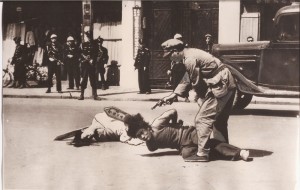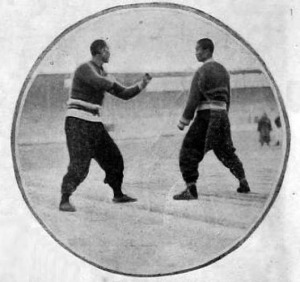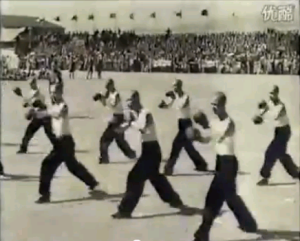Chinese Swordsmanship is defined by more than the type of sword in one’s hand.
Pages
Friday, April 30, 2021
Chinese Swordsmanship Defined ~ Scott M. Rodell
Wednesday, April 28, 2021
Chinese Swords and Swordsmanship: Qing New Army Sabers
Chinese Swords and Swordsmanship: Qing New Army Sabers
"After the Qing Defeat in the Sino-Japanese War, steps were taken to modernize the Chinese military. Yuan Shikai was tasked with organizing the New Army with the aid of German advisors. In addition to adopting new uniforms, modern rifles, machine guns and cannon, they also adopted a European Military style saber. This video looks at five examples of these late Qing sabers and the history that lead up to their use."
Monday, April 26, 2021
Saturday, April 24, 2021
Chinese Jian - The Two Types of Test Cutting - Scott Rodell
The Two Types of Test Cutting
Thursday, April 22, 2021
Tuesday, April 20, 2021
Sunday, April 18, 2021
Chinese Kung Fu - Decoding Martial Proverbs Extending Tendon, Pulling Bone, Bow, Arrow - Yang Hai
Chinese Kung Fu - Decoding Martial Proverbs Extending Tendon, Pulling Bone, Bow, Arrow - Yang Hai
Friday, April 16, 2021
Wednesday, April 14, 2021
Monday, April 12, 2021
Chinese Martial Arts History - David Ross - Central Martial Arts Academy
" According to the New Current Affairs Newspaper on August 20, 1930, after visiting Jpaan and training in Japanese martial arts, representatives of the Central Martial Arts Academy believed that the top priority of Chinese martial arts in this period was to eliminate the number of fancy methods and promote techniques suitable for practical applications".
Chinese Martial Arts History - David Ross
State attempts to control and appropriate the martial arts:
Phase One: Republican China
While some individual martial artists had gained status and social acceptance, as a group they continued to present a problem to central authority. Martial arts schools produced trained fighters who remained loyal only to their own teachers and traditions. Many still supported groups which openly challenged the newly established government.
The Nationalist Party (Guomindang) waswell aware of the role of martial artists in popular rebellion. In fact, Dr.Sun Yat-Sen, the founder of the party, had himself maintained numerous secret society associations and had extensively used “Red Pole” enforcers. Thus, once Chiang Kai-Shek had solidified his position, he turned his attention towards attempts to control and appropriate the practice of martial arts.
In 1928, a year after Chiang Kai-Shek’s “White Massacre” in Shanghai had left him the undisputed leader of the Nationalist Party, several steps were taken to exert control over martial artists. First, the government adopted the term “Kuo Shu”. This term means literally “national arts” and was an attempt not only to reduce the factionalism among martial artists but also to promote nationalism (and thus loyalty to the state).
Open challenges, duels or any kind of public fighting match was declared illegal. The government replaced these duels with state run competitions. These organized competitions were also to identify and screen the best practitioners for teaching positions at the newly founded Central Kuoshu Institute (中南國術館), and in the state administered provincial Kuo Shu institutes. Generals Zhang Zhi Jiang (张之江), Li Lie Jun (李烈鈞) and Li Jing Lin (李景林) held the first national competition in October 1928.
In 1929, a similar event was held in Hangzhou, China. This event was also organized by Li Jinglin, then acting as vice-dean of the Central Martial Arts Academy. This time there were 125 entrants for the “boxing” or “free fighting” (San Shou) competition which was held November 21-27. The event was very popular, the audiences every day numbered in the tens of thousands.
The same year, the governor of Guangdong Province invited some of the institutes’s masters (including some of those that had competed in the 1928 lei tai) to come south to establish a “Southern Kuoshu Institute”. General Li Jinglin chose five masters to represent northern China. These men were known as the Wu hu xia jiangnan (五虎下江南 – “Five tigers heading south of Jiangnan.
1. Gu Ru Zhang: Northern Shaolin. He placed in the “Top 15” of the 1928 lei tai.
2. Wan Lai Sheng: Northern Shaolin and Internal styles (including Natural Boxing).
3. Fu Zhensong: Baguazhang.
4. Wang Shao Zhou: Northern Shaolin and Cha style.
5. Li Xian Wu: Northern Shaolin and Internal styles.
Martial artists who participated in the institute but remained in China after the communist victory in 1949 have consistently denied any direct government involvement, for obvious political reasons, but in reality its establishment put martial artists under direct government regulation. Teachers in Taiwan are far more forthright, openly acknowledging that the government was involved in “an active program” to reorganize the martial arts. The stated goal of the institute was to “consolidate Kung-Fu by bringing together many great masters.” Thus, while the Nationalist Party was less successful, it was involved in a strikingly similar program to the one that the Chinese Communist Party (CCP) under took with the creation of contemporary Wu-Shu.
In 1933, the institute again hosted the national competition. The rules said, “…if death occurs as a result of boxing injuries and fights, the coffin with a body of the deceased will be sent home.” Some of the top winners of this contest included Chang Dung Sheng of Shuai Jiao. He won the heavy weight division and earned the martial nickname “Flying Butterfly.”
Attempts to control and appropriate the martial arts, like most Nationalist social programs, was largely unsuccessful. The government lacked a well-developed structure at the grass roots level and corruption was rampant. In addition, many of the most powerful members of the Nationalist Party were themselves martial artists. According to Draeger and Smith, the martial artists in Taiwan, many of whom were Nationalist Party members and military officers, “were a truly diverse lot: many were illiterate, some took opium regularly, a few were scoundrels.”
Found HERE
Saturday, April 10, 2021
Wednesday, April 7, 2021
Monday, April 5, 2021
Saturday, April 3, 2021
Saenchai Sparring UFC Champion | Zhang Wei Li | Khongsittha Muay Thai Gym | 张伟丽
Saenchai Sparring UFC Champion | Zhang Wei Li | Khongsittha Muay Thai Gym | 张伟丽










